
The manifestation is that the seal is softened or even dissolved. The cause is that the seal is invaded by the media and an error occurs in the selection of materials. Pay special attention if the media contains water or solvent.
2. Hardening (aging):
The reason for the leakage of the seal is often caused by the hardening of the material itself due to the influence of temperature. When the hardness is too high, the seal cannot fill the gap between the mating parts, and leakage will occur.
3. Wear:
The wear of the seals involves the surface finish, movement speed and transmission media of the matching parts. Different sealing materials adapt to different movement speeds.
4. Extrusion:
When the seal is subjected to excessive pressure, it will be squeezed into the metal gap, damaging the seal and causing leakage. This situation involves the hardness of the seal itself and whether the metal gap is too large. If it is designed, selected, processed or installed Improper handling will cause extrusion damage.
2. Leakage is one of the most frequently damaged phenomena of mechanical equipment. The main reasons for leakage are two aspects:
1. Mechanical processing will inevitably cause various defects, shape and size deviations on the surface, so gaps will inevitably occur at the joints of mechanical parts.
2. Once there is a pressure difference on both sides of the seal, the working medium will leak through the gap. The main way to prevent leakage: reducing or eliminating the gap is the main way to prevent leakage.
In the mechanical seal of the vacuum system, in addition to the direct leakage of the sealing medium through the sealing surface, the following two leakage forms should also be considered:
1. Leakage:
That is, under the effect of the pressure difference, the leakage of the sealed medium through the capillary of the sealing material is called leakage;
2. Diffusion:
That is, under the action of the concentration difference, the material to be sealed through the sealing gap or the capillary tube of the sealing material is transferred and diffused. The role of the seal is to seal the gap between the joint surfaces, isolate or cut off the leakage channel, increase the resistance in the leakage channel, or add small work elements in the channel, which will cause pressure on the leakage and partially offset the pressure difference that caused the leakage. Or fully balanced to prevent leakage.
















 RCCN WeChat QrCode
RCCN WeChat QrCode Mobile WebSite
Mobile WebSite